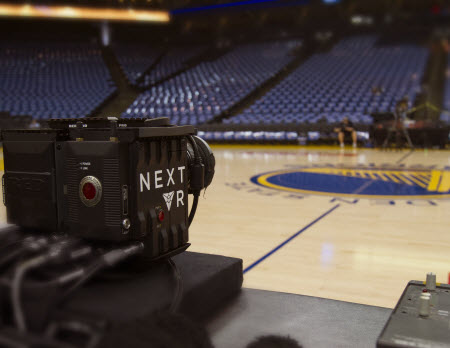NBA Makes Virtual Reality a Real Deal

The opening of the National Basketball Association season featured a notable score with some assist leaders, as the league, Turner Sports and NextVR offered up the first publicly available production of a live professional sports game in virtual reality (VR).
That opening night Golden State Warriors-New Orleans Pelicans game — including the ring ceremony for the NBA champion Warriors — is notable because it highlighted both the tremendous progress that has been made in the development of VR production technologies and some ongoing challenges that still require custom-built systems.
It’s a work in progress, and progress is ongoing. During the 2013-14 season, the league worked with NextVR to capture a Warriors-Denver Nuggets game, and in the 2014-15 season, NBA Digital — a partnership between Turner Sports and the NBA — delivered highlights of the All-Star Game and State Farm All-Star Saturday nights to fans.
The NBA Digital partnership is focused on enhancing the game experience, and Turner Sports and the league wanted to use the Warriors-Pelicans matchup to recreate the experience of watching a game at courtside, Turner Sports executive vice president and general manager Matt Hong said.
“One of the interesting stats from the league is that … the vast majority of basketball fans do not have the ability to attend a game in person,” Hong said. “So this was really an attempt to give people a virtual experience of the courtside experience.”
On the consumer side, the penetration of VR technologies is still relatively small, but many viewers could access the stream on the Oculus Home app via the NextVR portal without laying out the thousands of dollars that were needed for home equipment to view early HD, 3D and more recently 4K productions.
A $99 VR ‘SEASON TICKET’
Multichannel Newsletter
The smarter way to stay on top of the multichannel video marketplace. Sign up below.
Owners of newer Samsung phones could view the content on Samsung Gear VR headsets, which currently sell for less than $200 but will drop to $99.99 when a new model hits the market later this month.
On the production side, the VR feed required a separate crew and gear, Hong said, but those additional resources were “relatively light” compared to the 20 HD cameras and mobile truck used for Turner’s regular production of the game.
For the presentation, NextVR used a mobile production flight pack for the arena with a switcher, mixer, monitors and other gear, NextVR cofounder DJ Roller said. The rigs, each of which was equipped with two Red Digital Cinema cameras, were linked by fiber to the switcher, which was supplied by For-A, and other equipment so that no camera operators were needed.
“We had four rigs, with two cameras a rig,” Roller said. “There was one at midcourt, one under the basket, one at mid-level in the arena and a fourth was a roving camera that put the audience out on the floor, as if you were standing there during the ring ceremony.”
The system is capable of switching between cameras as a director might during a regular telecast, “but for this production we wanted to recreate the live game experience,” with very lengthy shots from center court and other camera positions, Roller said.
Keeping with that approach, the feed had no ads or any of the usual graphics or play-by-play announcers. The audio focused on natural sounds, such as crowd noises and the squeak of sneakers on the floor. Regular audio was supplemented by binaural microphones, which are shaped something like human ears to help achieve an immersive sound experience, Roller said.
Unlike the early experiments with HDTV and 4K feeds, NextVR technologies, which include their own encoders and codec, required only 6 Megabits per second of data. Thus, the feeds are viewable on phones with just a 3G, 4G or WiFi connection.
A WORK IN PROGRESS
The reduced bandwidth and higher-quality stereoscopic VR feed rests on technologies that the company has been developing over a number of years. Roller noted that they had initially used “stitching technologies” that knit together different images from different cameras to create a 180- or 360-degree view.
The process of stitching the images together creates seams that then need to be laboriously blurred out, though, and that makes the systems less appealing for live production and reduces overall video quality.
To overcome those problems, NextVR has developed 23 patents that have been approved or are pending. Using a proprietary codec and a variety of metadata and spatial information, images from the camera are rendered onto what Roller compares to a matrix as it reaches the viewer without the need to stitch overlapping images together.
“It is completely different from what everyone else is doing,” he said.
While much of NextVR’s capabilities rest on custom- built technology, Roller said the company has always worked to create technology that “is practical and implementable in a broadcast environment.”
“We’ve had to build a lot of things from the ground up, but ultimately we hope that you will be able to buy these cameras and equipment off the shelf,” he said.
